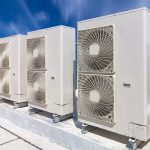Renewable Heating for Churches
Renewable heating is always a challenge in churches particularly when it comes to preserving heritage. There are multiple forms of renewable heating available, many of which are potentially workable, however, they are nearly always bulky, often require significant modification to the fabric of the building and can be very costly.
Redesigning the heating to achieve net zero carbon in a church or any historical building requires meticulous planning and a lot of creativity.
Below we explore some of the options and some ideas on how we can overcome issues with heritage, outlay and running costs.
A few things to bear in mind: Most older churches have a very high heat loss due to little insulation, high ceilings, stone walls, single glazed windows and in other words keeping them warm is always a challenge.
Many churches are used as little as only on a Sunday with the occasional one-offs, meaning an allowance for extra heating power is necessary to warm up the church for a service as, the heating is not running all week.
Air-Source Heat Pumps:
ASHP’s are fast becoming the go-to for renewable heating systems. Achieving an incredible 400% efficiency they can be a great way to heat a building. They can also be situated inside a building and ducted to outside. This can be a help when trying to obtain permission for the unit and preserve heritage as they take up a great amount of space and can be a bit of an eyesore on the outside of a beautiful church. Other options could be to have them in an enclosure built from a similar fabric to the church.
Air source heat pumps also require very little maintenance compared with other renewable heating options such as biomass. However, they are only efficient supplying a system up to temperatures of about 50°C maximum. This means that they will not work well with an existing radiator or fan convector heating system so the church will likely have to install underfloor heating. This is nearly always very costly and not the most practical solution for many churches as underfloor has very slow warm up times. However, refer to the Water Source Heat pumps as there are ways round this.
If permission can be granted, it is usually best to install the heat pumps outside in their own separate compartment, which could be a small distance from the actual church.
As with all heat pumps, particularly to heat a space as large as a church, 3 phase power is nearly always required. This is not something many churches currently have so upgrading the power is also something that must be taken into consideration.
Electric Boilers:
Electric boilers work exactly like a gas boiler only they are powered by electricity. They are 100% efficient so the running costs would be substantially higher than either a natural gas boiler or a heat pump. They do however require a large electricity supply so this is not a viable option for many churches without first upgrading the electrical supply to the church.
Gas absorption heat pump:
Whilst not completely net zero carbon is getting very close to it. This is technology that has been around for a while but is now becoming increasingly popular due to its low emissions. It is essentially a hybrid of an air source heat pump and a gas boiler giving you the low running costs of a gas boiler with the high efficiencies and low carbon emissions of a heat pump all in one unit.
Ground-Source Heat Pumps:
GSHP’s are similar to air source but slightly more efficient as they take the heat from the ground which is generally warmer than the air during winter. However, these do require a great amount of outdoor space. This is rarely something churches have particularly where there are graves around the church. They are also more expensive to install than air source.
Water-Source Heat Pumps:
As you can well imagine water source heat pumps work like air source and ground source but take the heat from water. You may be thinking this is no good as there is no warm water any where near the church. However, they do have a really useful application. You can use an air source heat pump to heat a buffer vessel (basically a cylinder for storing hot water) up to about 50°C, then use the water source heat pump to top the temperature up to 80°C. This means you can now run your existing system without the need to change to underfloor heating. Do bear in mind however that you will need a lot of plantroom space for this to happen.
Biomass
Biomass boilers use wood chips as a fuel. This makes them completely net zero and sustainable as with many of the others e.g. heat pumps, they are only truly net zero carbon if the electricity that supplies them comes from a sustainable source. Biomass however is very high maintenance and we now seem to be getting many enquiries to take them out and replace them with something else as they are basically hassle.
Solar
Solar panels are a great way to heat your church for, in essence, free. Unfortunately, covering a church roof with solar panels is probably only enough to keep a small vestry warm. Not to mention trying to get planning permission. However, where they could come in useful is to heat a small cylinder for hot water as there is not often a huge demand for hot water in a church.
They can also be useful in conjunction with other sources of renewable heating. Solar PV is definitely worth considering to help provide some of the electricity for say an air source heat pump.
Hydrogen
Although this is not something that is yet available we thought this is definitely a point worth mentioning as if it does come then the chances are this will be the new natural gas. Many new conventional boilers are now available as hydrogen ready meaning that if this comes about your boiler can easily be adjusted to burn hydrogen as the main fuel rather than buying a new boiler. If running costs are a issue for your church then buying a new gas boiler that is hydrogen ready may be the way to go for the time being until technologies improve.
Hybrid Systems
At the current time we feel that some form of hybrid system is the way forward for churches wanting to move towards a carbon neutral heating system. Many hybrid systems will get you 80% of the way there without extremely expensive running costs. i.e electricity is 3-4 times the price of gas per kWh. A good example of this is to have an air source heat pump providing the majority of your heating system and having a gas boiler for when temperatures drop below 7°C to make up the difference. This not only means you are more likely to fit the equipment on site as the size of the heat pump will not need to be so large but also it will mean the heating system runs far more efficiently.





